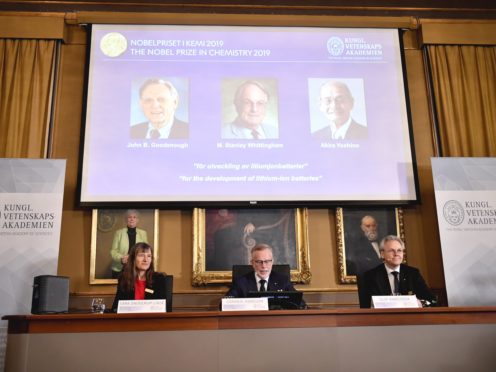
Three scientists have been awarded the Nobel Prize in Chemistry for their contributions to the development of lithium-ion batteries.
The prize went to John B Goodenough of the University of Texas; UK-born M Stanley Whittingham of the State University of New York at Binghamton; and Akira Yoshino of Asahi Kasei Corporation and Meijo University in Japan.
Goran Hansson, secretary general of the Royal Swedish Academy of Sciences, said the prize was about “a rechargeable world”.
The 2019 #NobelPrize in Chemistry has been awarded to John B. Goodenough, M. Stanley Whittingham and Akira Yoshino “for the development of lithium-ion batteries.” pic.twitter.com/LUKTeFhUbg
— The Nobel Prize (@NobelPrize) October 9, 2019
In a statement, the committee said lithium-ion batteries “have revolutionised our lives” — and the laureates “laid the foundation of a wireless, fossil fuel-free society”.
The Nobel committee said the lithium-ion battery has its roots in the oil crisis in the 1970s, when Mr Whittingham was working to develop methods aimed at leading to fossil fuel-free energy technologies.
The prizes come with a nine-million kronor (£738,000) cash award, a gold medal and a diploma that are conferred on December 10 — the anniversary of Nobel’s death in 1896 — in Stockholm and in Oslo, Norway.
In the early 1970s, Stanley Whittingham, awarded this year’s Chemistry Prize, used lithium’s enormous drive to release its outer electron when he developed the first functional lithium battery.#NobelPrize pic.twitter.com/lRD2zBNm4T
— The Nobel Prize (@NobelPrize) October 9, 2019
Prize founder Alfred Nobel, a Swedish industrialist who invented dynamite, decided the physics, chemistry, medicine and literature prizes should be awarded in Stockholm, and the peace prize in Oslo.
On Tuesday, Canadian-born James Peebles won the Physics Prize for his theoretical discoveries in cosmology together with Swiss scientists Michel Mayor and Didier Queloz, who were honoured for finding an exoplanet — a planet outside our solar system — that orbits a solar-type star.

Americans William G Kaelin Jr and Gregg L Semenza and Britain’s Peter J Ratcliffe won the Nobel Prize for advances in physiology or medicine on Monday.
They were cited for their discoveries of “how cells sense and adapt to oxygen availability”.
Two literature laureates are to be announced on Thursday, because last year’s award was suspended after a scandal rocked the Swedish Academy.
The coveted Nobel Peace Prize will be announced on Friday and the economics award on Monday.

Enjoy the convenience of having The Sunday Post delivered as a digital ePaper straight to your smartphone, tablet or computer.
Subscribe for only £5.49 a month and enjoy all the benefits of the printed paper as a digital replica.
Subscribe